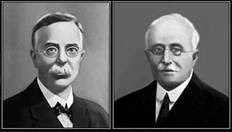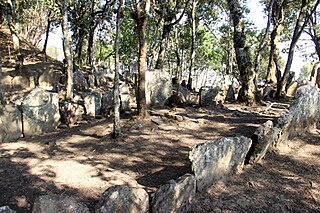
Mizoram is a landlocked state in northeast India, with Aizawl as its seat of government and largest city. Within India's northeast region, it is the southernmost state, sharing borders with three of the Seven Sister States, namely Tripura, Assam and Manipur, and also shares a 722-kilometre (449 mi) border with the neighbouring countries of Bangladesh and Myanmar. The state spans over an area of approximately 21,087 square kilometres, of which approximately 91% is forested. With an estimated population of 1.25 million in 2023, it is the second least populous state in the country.
Mizo Union was the first political party in Mizoram, northeast India. It was founded on 6 April 1946 at Aizawl as the Mizo Common People's Union. At the time of independence of India from the british rule in india in 1947, the party was the only political force in the Lushai Hills. It won the first Mizoram District Council general election under the new Indian Union in 1951, and consecutively in 1957, 1962 and 1966.

The Mizo people, historically recorded as the Lushais, are an ethnic group native to the state of Mizoram in India and neighbouring states of Northeast India. They speak the Tibeto-Burman language of Mizo, the official language and lingua franca of Mizoram. The state is the second most literate state in India, at more than a rate of 90%.

Lunglei, formerly known as Lungleh, is the second-largest town situated in the south-central part of Mizoram, northeastern India. The city served as the capital of British Mizoram from 1889 to 1898. Due to its location, it has been serving as a commercial hub for southern Mizoram.

The Kuki people are an ethnic group in the Northeastern Indian states of Manipur, Nagaland, Assam, Meghalaya, Tripura and Mizoram, as well as the neighbouring countries of Bangladesh and Myanmar. The Kukis form one of the largest hill tribe communities in Northeast India, along with the adjoining regions of Bangladesh and Myanmar. In Northeast India, they are present in all states except Arunachal Pradesh. The Chin people of Myanmar and the Mizo people of Mizoram are kindred tribes of the Kukis. Collectively, they are termed the Zo people.

The Mizo language is a Tibeto-Burman language spoken mainly in the Indian state of Mizoram, where it is the official language and lingua franca. It is the mother tongue of the Mizo people and some members of the Mizo diaspora. Other than Mizoram, it is also spoken in Meghalaya, Manipur, Tripura, and Assam states of India, Sagaing Region and Chin State in Myanmar, and Chittagong Hill Tracts of Bangladesh. It is mainly based on the Lusei dialect but it has also derived many words from its surrounding Mizo clans.
Laldenga was a Mizo separatist and politician from Mizoram in northeast India. He was the founder of the Mizo National Front, a social organisation turned political party. He was the first Chief Minister of Mizoram as a federated state, the office of which he held from 1986 to 1988.

Tlabung, formerly known as Demagiri, is a census town in Lunglei district in the Indian state of Mizoram.

The Biates are an ethnic hill tribe of Assam, Meghalaya, Mizoram, Tripura and Manipur. Their language belongs to the Tibeto-Burman family. Spread over many parts of North-East India, they have a unique identity with a rich and distinctive history, culture, dialect and religious heritages. They are one of the oldest hill tribes of North East India especially among the Chin-Kuki-Mizo people. The term Biate comes from the word Bia-te. The word ‘Bia’ or ‘Biak’ means ‘speak’ or ‘worship’. ‘Te’ is a suffix denoting plurality. Hence, the two words combine to form the word Biate, which means worshipper.

James Herbert Lorrain, or Pu Buanga, was a Scottish Baptist missionary in northeast India, including Mizoram, Assam, and Arunachal Pradesh. He and Frederick William Savidge reduced the Lushai language to writing—devised an alphabet using Roman lettering and phonetic form of spelling based on Hunterian system translation; compiled grammar and dictionaries for missionary activities and clerical administration.
William Williams was a Welsh Presbyterian missionary to Khasi Hills, northeast India, in the late 19th century. He was a son of a ship captain in Nanternis, a small village in Wales. Following his father's footstep he became a sailor for five years. Then he took a profession in carpentry for two years. After graduating in theology from East London Missionary Training Institute he became a pastor. Pursuing his ambition he became a missionary of the Welsh Calvinistic Methodist Foreign Mission to Khasi people in India from 1887 until his death. He died of typhoid in 1892.

Education in Mizoram consists of a diverse array of formal education systems ranging from elementary to university, from training institution to technical courses. The Government of India imposes mandatory education at least up to the basic level. For this public schools are made free of fees, and provided with free textbooks and school lunch.
David Evan Jones, Mizo name Zosaphluia, was a Welsh missionary to the Mizo people in the Lushai Hills, what is now Mizoram, India.

Frederick William Savidge was a pioneer English Christian missionary in northeast India. He and James Herbert Lorrain brought Protestantism to Mizoram, and some parts of Assam and Arunachal Pradesh. Together they were entirely responsible for the creation of written language in Mizo, beginning of literacy, origin of formal education and establishment of churches in Mizoram. They devised the original Mizo alphabets based on Roman script, prepared the first book and dictionary in Mizo, started the first school among the Mizos. Mizoram has become the most Christian populated state in India. As a professional educator Savidge was single-handedly responsible for introducing quality education in Mizoram. He is deservedly known as the Father of Mizo Education.
Edwin Rowlands was a Welsh Christian missionary in northeast India and Burma. He was a professional teacher, singer, composer, poet, translator and literary figure among the Mizo people. He was regarded as the most beloved of all British missionaries in Mizoram. He was more popularly known as Zosapthara. He made the major hymns in Mizo and Khumi which are still in use. He modified the original Mizo alphabet and his system became the standard in Mizo language. He created written language for Khumi people in Burma, and for Bhil people in Maharashtra. His literary works are the foundation of Mizo literature. He was the first administrator of education in Mizoram as Honorary Inspector of Schools. Despite objection from various corners he married Thangkungi, a Mizo girl.

The history of Christianity in Mizoram covers the origin and development of all forms of Christianity in Mizoram since the British occupation at the end of the 19th century. Christianity arrived as a consequence of tribal warfare, raids of British plantations, and the ensuing punitive British military expedition called the Lushai Expedition of 1871. The subsequent annexation of the erstwhile Lushai Hills to the British Empire opened the gateway for British Christian missions to evangelise the Mizo people.

Mizoram is a state in the northeast of India. Mizoram is considered by many as a beautiful place due to its landscape and pleasant climate. There have been many attempts to increase revenue through tourism but many potential tourists find the lack of amenities to be a hurdle. However, the State continues to promote itself and many projects have been initiated. The tourism ministry continues to maintain or upgrade its tourist lodges throughout the state. Foreign tourists are required to obtain an 'inner line permit' under the special permit before visiting. The permit can be obtained from Indian missions abroad for a limited number of days or direct from Mizoram Government authorities within India. The state is rich in bird diversity, which has the potentiality to make it a major birding destination. Mizoram is a stronghold for Mrs. Hume's pheasant. There is also a rare record of the wild water buffalo from the state. There are several past records of the Sumatran rhinoceros from Mizoram, then Lushai Hills. The small population of wild elephants can be seen in Ngengpui and Dampa Sanctuaries.
The Mizoram Peace Accord, 1986 was an official agreement between the Government of India and the Mizo National Front (MNF) to end insurgency and violence in Mizoram, India, that started in 1966. The Mizo National Front was an organisation of Mizo secessionists led by Laldenga to fight for independence from India. The movement was basically due to lack of support from the government during the great famine in Mizoram in the late 1950s. Political insurgency and social unrest ensued in the next decades. After a number of negotiations, the document titled Mizoram Accord, 1986: Memorandum of Settlement was finally signed on 30 June 1986. It was signed by Laldenga for MNF, R.D. Pradhan, Home Secretary, Government of India, and Lalkhama, Chief Secretary, Government of Mizoram. It is remarked as the most and only successful peace agreement in India after its independence from British Empire in 1947.

British rule in the Lushai Hills, spanning from the late 1889 to the 1947, commenced with the Chin-Lushai Expedition of 1889-90 leading to the formal establishment of the two administrative districts in 1889 and continued through the integration of the regions into the province of Assam with both districts being merged as the Lushai Hills until India gained independence in 1947.

The Mizo District, formerly called Lushai Hills District, was an autonomous district of the Indian state of Assam from 1947 till 1972 until it was granted the status of a Union Territory. This region was a significant part of Mizo history as it formally abolished the Mizo chieftainship system in 1952.













